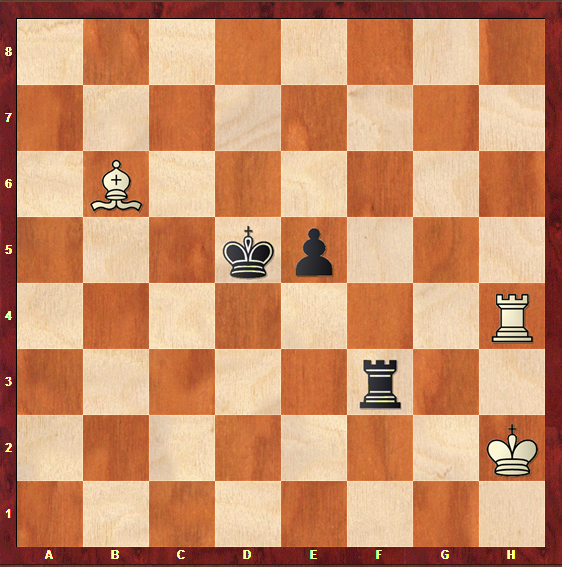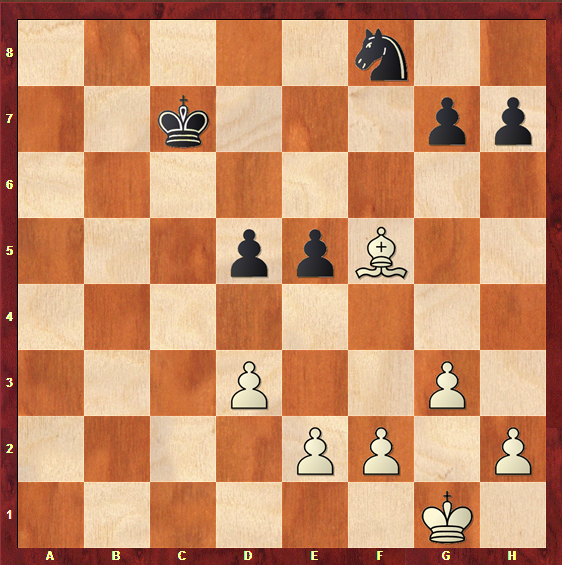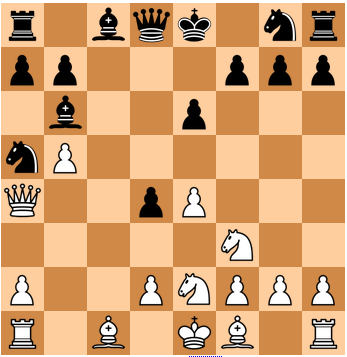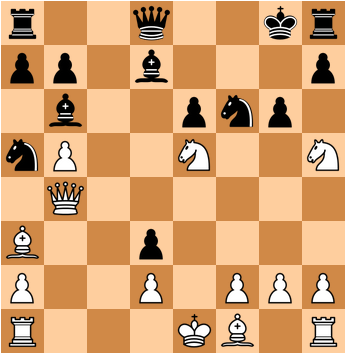In my past two tournaments, I confess that I got lucky in a couple games. Big time…
In the past, I’d gotten ridiculously fortunate in some games. This endgame is probably my most insane swindle ever:
Abdi, Farzad (2254) – Brodsky, David (2305) Eastern Class Championship 2015

White to play
As black, I had the infamous f-pawn. The problem, however, was that it was still on f3. If it were on f2, it would be a draw.
In the textbooks, against the pawn on f3, white wins by giving checks, eventually forcing the black king in front of the pawn, bringing his own king closer to the pawn, and so on until white can win the pawn or give mate.
However, white has only one winning move here, 68.Qa6+!. There white performs the process described above. Had he played it, I would have resigned in a few moves. Instead, my opponent gave another seemingly fine check, 68.Qa1+??.
Where’s the catch? Try to find it.
I went 68… Kg2 69.Qg7+ Kf1!. Incredibly, white has no other checks besides Qa1+ and Qg7+. He cannot force the black king to f2! It is a draw!
Does this qualify as a swindle? I admit I went for this endgame a) because I had nothing better and b) as an excuse not to resign immediately. I guess it was sort of a swindle, as I doubt my opponent thought there was only one winning move. Especially considering that he had a queen, everything should be winning, right?
That game was played over 2 years ago (time flies!), and since then, none of my swindles has come anywhere near that one. It’s really, really, really rare that something like this happens. But if you keep trying, fortune will smile at you eventually.
Luck aside, it’s your job to try and trick your opponent in positions where you are pressing but don’t have enough to objectively win. You can’t count on them making mistakes out of the blue, but you can give them an opportunity or two to make those mistakes. As they say, in chess, you make your own luck.
In endgames, chances are both you and your opponent are getting low on time and tired, mistakes will start creeping into your play, and your calculation start getting faulty… In my humble opinion, the endgame is as good a phase of the game as any to swindle your opponent.
Still, how to do it? I have three pieces of advice:
- come up with innovative ideas (that have a chance of working)
- lay (realistic) traps
- keep trying
Did I mention keep trying? By that, I don’t mean play king + rook vs. king + rook for 50 moves hoping your opponent generously blunders his rook or gets mated. No! I mean keep trying realistic winning attempts. If you throw enough of them at your opponent’s head, he may eventually crack.
The question is how to best combine the three. The traps shouldn’t be that obvious. There is a reason why they are called traps. Still, there are only so many non-obvious traps in the position… In the following two games, those were the kinds of questions I had to answer.
Let’s first start with my round 2 game from the Cherry Blossom Classic:
Brodsky, David (2485) – Fellman, Mike (2201)

White to play
Earlier in the game, I had expected to get more out of my position, but somehow it didn’t materialize. The position’s big trump is my b-pawn, which is fairly advanced. I can go 64.Rh8, harassing the black bishop. However, black will most likely go 64… Rg3+ 65. Kh2 Bxb6 66.Bxb6 Rxf3 67.Rxh4

Black to play
This is of course a draw, but holding rook + bishop vs. rook is not an easy task, as practice has shown. However, black has an extra pawn, and it is strong and centralized. Will I be able to even win that e-pawn? Unlikely. That did not seem promising.
How to proceed? Go for that endgame and hope it’ll work out? Honestly, I felt that I should try something else to see if it worked before trying that option.
I went 64.Kh2 Rb7 65.Kh1!?. My idea was to get out of Rg3+ if my opponent went back with 65… Rg7 which is what happened. It was not necessary for him to go back, and probably another rook move like 65… Rf7 would have made his life easier. I now went 66.Rh8!.

Black to play
Now black has to decide how to react. 66… Bf6 might lead to trouble after 67.Rc8 followed by Rc7. Probably the best thing to do is to bail out with 66… Bxb6! 67.Bxb6 Rf7 68.Kg2 e4 69.fxe4 (69.Rh5+ Kc6! attacking the bishop is a key resource. It’s understandable to miss it in the heat of the battle.) 69… Kxe4 70.Rxh4+ after which we get rook + bishop vs. rook, without any pawn for black. Compared with the position I could have gotten had I played 64.Rh8, this is an improvement! Winning rook and bishop vs. rook would be another story, but at least white realistically has serious winning chances there.
Instead, my opponent made the losing mistake with 66… Rd7?. After 67.b7!, black has to give up his bishop for the pawn, and he can’t get the white f-pawn off the board. I won the game a few moves later.
Just like that, in three moves, I turned a seemingly nothing position into a winning one! What’s the moral of the story? My best interpretation is that ideas like Kh3-h2-h1, which at first glance look ridiculous, can actually be good.
Last weekend, I had another endgame where I swindled my opponent in a similarly drawn endgame. But first a warning: this endgame was a lot more complicated than the previous one. The game itself was unusual and interesting, and I’ve decided to analyze this one starting right after the time control, where I had to make decisions how best to make my opponent’s life miserable.
Brodsky, David (2477) – Subervi, Jonathan (2249) Northeast Open 2017

Black to play
I had been better for most of the game, but a careless move had blown it all away. White is temporarily a pawn up, but black will win it back after he takes the c6-pawn. With my last move, 40.Nd2-f3, I reached the time control, attacked his bishop, and realized I had absolutely nothing if my opponent played 40… Bxc3 41.Nxg5 e5!. It will be equal material once black takes the pawn, and I’ve got to be careful about black’s passed b-pawn.
Instead, my opponent, who was in time trouble, played 40… Bf4?. Now, I had some time to decide what to do next. If you want, take a think and see what you can come up with for white.
The critical move was 41.Nd4, as it leads to a pawn endgame after the moves 41… e5 42.Ne6+ Kxc6 43.Nxf4 gxf4. Then, it turns into a race after 44.Kf3 (or Kh3) Kc5 45.Kg4 Kc4 46.Kf5 Kxc3 47.Kxe5 b5 48.Kxf4 b4 49.e5 b3 50.e6 b2 51.e7 b1Q 52.e8Q

Black to play
I saw this position in my calculations, and I thought I should have good winning chances, as black can’t check me with 52… Qc1+? because of 53.Qe3+, forcing a queen trade into a winning pawn endgame. Tablebases confirm my suspicions by telling me that this position is mate in 67 (!). Of course, I had no way of knowing that, but during the game, this looked like a decent winning attempt to me.
Then, it was time to see if black has any alternatives in that variation, and that’s how I found the move which troubled me. On move 48, instead of paying 48… b4, black should go 48… Kd4! 49.e5 Kd5 50.Kf5 b4 51.e6 b3 52.e7 b2 53.e8Q b1Q+.

White to play
Ironically, black queens last in this version, but he does so with check. His king is a lot better positioned in this version, meaning that it a) won’t get in the way of black’s checks and b) could help stop the f-pawn in some variations, even making some pawn endgames a possibility. I was not confident that I would win this position, and tablebases do confirm that this position is a draw.
Time to backtrack. Is it a good idea to go down that forcing path with 41.Nd4? I don’t have any real way to get out of those lines. If my opponent finds the move 48… Kd4!, will I have anything?
Therefore, I decided to go for another option, 41.Kh3, where I didn’t see a totally forced draw for black. The game went 41… Kxc6 42.Kg4 Kd6 43.Nxg5 Bd2
White is a pawn up, but black will win the c-pawn in exchange for the e6-pawn. That appears to be promising, but the black b-pawn runs fast and cannot be easily stopped by the white knight. Still, it’s the best I have.
I decided to go for fancy tricks with 44.e5+!?. 44.c4 would have led to something similar. The game went 44… Kd5 45.c4+ Kxc4 46.Nxe6. This leads to the kind of position described above. The turned into a pawn race after 46… b5 47.Nc7 b4 48.e6 b3 49.e7 b2 50.e8Q (50.Nb5!? is one of those study-like moves that could work in some positions and you should be on the lookout for, but I didn’t think it would be effective after 50… Bb4) b1Q

White to play
From afar, I had thought that because I queen first, I should be able to get something against the black king. Plus, the queen and knight are a tricky combo and are good at creating mating threats. However, that isn’t the case. The deeper I looked, the more I realized that I have no forced win or anything.
How to proceed? Well first of all, if I wanted to win this one, I’d need to hide my king from perpetual checks. The black checks can come from everywhere, but the ones on the b1-h7 diagonal are preventable. The tricky ones, however, are the ones that come on the first rank (Qg1+ and maybe Qd1+). Therefore, I decided to drive the black king to the first rank so that my king could hide. The game went 51.Qc6+ Kb3 52.Qb5+ Kc2 53.Qc4+ Kd1 54.Kf3 Qf5+ 55.Kg2 Qg5+ 56.Kf1 Qf5 57.Nd5

Black to play
My king is hidden from the checks, and my knight is coming closer towards the black king. The position is still objectively drawn, but there’s nothing forced.
Now, for laying traps. What are some of black’s most compelling moves? There is no obvious follow-up if 57… Qh3+ 58.Kg1. What else? How about 57… Qf3 threatening Qh1#? If 58.Kg1, black has 58… Qe2! and white’s coordination is getting disrupted.
My opponent, not seeing the trap, played that. Can you find the nasty surprise I had in store for my opponent?
I went 58.Ne3+! Bxe3 59.Qd3+. Black can’t move his bishop because it’s pinned, and after 59… Kc1 60.Qxe3+ I force a queen trade after which black can’t catch the white pawn. My opponent had to resign.
I do admit that last endgame was one heck of a ride! Still, it goes to show that chess is a hard game and that tricks and traps do work sometimes. However, laying those traps is the hardest part, but if you try, you may get lucky. Good luck with your future swindles!











 Me moments after reaching 2400.4!
Me moments after reaching 2400.4!



 Still enjoying chess… Photo by Vanessa Sun
Still enjoying chess… Photo by Vanessa Sun Me with Dr. Frank Brady and Frank Marshall…
Me with Dr. Frank Brady and Frank Marshall…
































